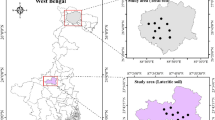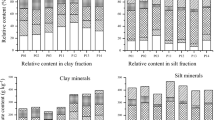Abstract
The acidification of paddy fields was studied in Guizhou Province, China. Affected by acid mine drainage, the pH value of irrigation water was 2.9 with the concentrations of iron and aluminium above 40 mg/L. Based on the pH(H2O) of topsoil, the paddy fields studied were classified spatially into three zones, the natural zone (pH value from 6.2 to 5.5), the acidified zone (pH value from 5.5 to 4.5), and the seriously acidified zone (pH value from 4.5 to 3.2), respectively. Comparing to the natural zone, the buffering processes for acidification of paddy soil were discussed by considering the changes of calcium, magnesium, potassium and aluminium in soils. The Ca, Mg and K were leached from the soil by the decomposition of carbonate and kaolinite. The leaching of Mg became less with the enrichment of iron in topsoil layer. When the soil pH was below 5.0, aluminium was leached from soil because of the dissolution of alumino silicate minerals. In addition, the hydrolysis of iron and aluminium in soil provided more protons to promote the soil acidification. Furthermore, the buffer capacity of paddy soil was discussed by the results of buffer experiment, based on which the pH buffer curve was drawn and the empirical formula for calculating the acidification rate was developed. Because pH buffer capacity of soil is about 2.78 cmolc/kg pH for the pH(H2O) value above 5.0, it is estimated that only another 50 years are needed for the pH(H2O) of the paddy soil decrease to 3.5 in the acidified zone if the acid water is used for irrigation continuously.







Similar content being viewed by others
References
Adamson JK, Rowland AP, Scott WA, Hornung M (1996) Changes in soil acidity and related variables over 25 years in the North Pennine Uplands, UK. Soil Use Manag 12:55–61
Bigham JM, Schwertmann U, Carlson L (1992) Mineralogy of precipitates formed by the biogeochemical oxidation of Fe(II) in mine drainage. In: Skinner HCW, Fitzpatrick RW (eds) Biomineralization processes of iron and manganese: modern and ancient environments. Catena Verlag, Cremlingen Destedt, pp 219–232
Blake L, Goulding KWT, Mott CJB, Johnston AE (1999) Changes in soil chemistry accompanying acidification over more than 100 years under woodland and grass at Rothamsted Experimental Station, UK. Eur J Soil Sci 50:401–412
Bohn HL, McNeal BL, O’Connor GA (2001) Soil chemistry, 3rd edn. Wiley, New York
Boruvka L, Mladkova L, Drabek O (2005) Factors controlling spatial distribution of soil acidification and Al forms in forest soils. J Inorg Biochem 99:303–321
Conyers MK, Heenan DP, Poile GJ, Cullis BR, Helyar KR (1996) Influence of dryland agricultural management practices on the acidification of a soil profile. Soil Tillage Res 37:127–141
Ding ZH, Zheng BS, Long JP, Belkin HE, Finkelmam RB, Chen CG, Zhou DX, Zhou YS (2001) Geological and geochemical characteristics of high arsenic coals from endemic arsenosis areas in southwestern Guizhou Province, China. Appl Geochem 16:1353–1360
Drabek O, Boruvka L, Mladkova L, Kocarek M (2003) Possible method of aluminium speciation in forest soil. J Inorg Biochem 97(1):8–15
Dubikova M, Cambierb P, Suchaa V, Caplovicova M (2002) Experimental soil acidification. Appl Geochem 17:245–257
Falkengren-Grerup U, Linnermark N, Tyler G (1987) Changes in acidity and cation pools of south Swedish soils between 1949 and 1985. Chemosphere 16:2239–2248
Farmer A (1995) Soil chemistry change in a lowland English deciduous woodland 1974–1991. Water Air Soil Pollut 85:677–682
Frempong EM, Yanful EK (2006) Chemical and mineralogical transformations in three tropical soils due to permeation with acid mine drainage. Bull Eng Geol Environ 65:253–271
Fujii K, Funakawa S, Hayakawa C, Kosaki T (2008) Contribution of different proton sources to pedogenetic soil acidification in forested ecosystems in Japan. Geoderma 144:478–490
Hallbacken L, Tamm CO (1986) Changes in soil acidity from 1927 to 1982–84 in a forest area of southwest Sweden. Scand J For Res 1:219–232
Hamer R, Graham RC, Amrhein C, Bozhiloc KN (2003) Dissolution of rippidolite (Mg, Fe-chlorite) in organic and inorganic solutions. Soil Sci Soc Am J 67:654–661
Helyar KR, Cregan PD, Godyn DL (1990) Soil acidity in New South Wales-current pH values and estimates of acidification rates. Aust J Soil Res 28:523–537
Kalinowski BE, Schweda P (1996) Kinetics of muskovite, phlogopite, and biotite dissolution and alteration at pH 1–4, room temperature. Geochim Cosmochim Acta 60:367–385
Kauppi P, Kamari J, Posch M, Kauppi L (1986) Acidification of forest soils: model development and application for analyzing impacts of acidic deposition in Europe. Ecol Model 33:231–253
Kirby CS, Cravotta CA (2005) Net alkalinity and net acidity 1: theoretical considerations. Appl Geochem 20:1920–1940
Kuylenstierna JCI, Chadwick MJ (1991) Increases in soil acidity in north west Wales between 1957 and 1990. Ambio 20:118–119
Lesturgez G, Poss R, Noble A, Grünberger O, Chintachao W, Tessier D (2006) Soil acidification without pH drop under intensive cropping systems in Northeast Thailand. Agric Ecosyst Environ 114:239–248
Loss SP, Ritchie GSP, Robson AD (1993) Effect of lupins and pasture on soil acidification and fertility in Western Australia. Aust J Exp Agric 33:457–464
Martin F, Diez M, Garcia I, Simon M, Dorronsoro C, Iriarte A, Aguilar J (2007) Weathering of primary minerals and mobility of major elements in soils affected by an accidental spill of pyrite tailing. Sci Total Environ 378:49–52
Nelson PN, Su NH (2010) Soil pH buffering capacity: a descriptive function and its application to some acidic tropical soils. Aust J Soil Res 48(3):201–207
Noble AD, Suzuki S, Soda W, Ruaysoongnern S, Berthelsen S (2008) Soil acidification and carbon storage in fertilized pastures of Northeast Thailand. Geoderma 144:248–255
Rayment GE, Higginson FR (1992) Australian laboratory handbook of soil and water chemical methods. Australian soil and land survey handbooks, vol 3. Inkata Press, Melbourne
Reuss JO, Walthall PM, Roswall EC, Hopper RWE (1990) Aluminum solubility, calcium–aluminum exchange, and pH in acid forest soils. Soil Sci Am J 54:374–380
Rhoades JD (1982) Cation exchange capacity. In: Page AI, Miller RH, Keeney DR (eds) Methods of soil analysis. Part 2-chemical and microbiological properties, 2nd edn. American Society of Agronomy, Madison, pp 149–157
Salm C, Kohlenberg L, Vries W (1998) Assessment of weathering rates in Dutch loess and river-clay soils at pH 3.5, using laboratory experiments. Geoderma 85:41–62
Schwertmann U, Bigham JM, Murad E, Schwertmann U, Bigham JM, Murad E (1995) The first occurrence of schwertmannite in a natural stream environment. Eur J Mineral 7:547–552
Singh B, Odeh IOA, Mcbratney AB (2003) Acid buffering capacity and potential acidification of cotton soils in northern New South Wales. Aust J Soil Res 41:875–888
Slattery WJ, Edwards DG, Bell LC, Coventry DR, Helyar KR (1998) Soil acidification and the carbon cycle in a cropping soil of north-eastern Victoria. Aust J Soil Res 36:273–290
Swayze GA, Smith KS, Clark RN, Sutley SJ, Pearson RM, Vance JS, Hageman PL, Briggs PH, Meier AL, Singleton MJ, Roth S (2000) Using imaging spectrometry to map acidic mine waste. Environ Sci Technol 34:47–54
Tang CY, Wu P, Tao XZ, Zhang CP, Han ZW (2009) The basin acidification affected by AMD: a case study in Xingren county, Guizhou. China. Carsologica Sinica 28(2):135–143
USEPA (1995) Test methods for evaluating solid waste. Microwave assisted acid digestion of siliceous and organically based matrices. US Environmental Protection Agency, Washington DC
Wang JH, Zhang XN, Yu TR (1994) Study on sensitivity of red soils to acid rain in south China. Acta Pedol Sin 31(4):348–355
Wang JD, Gao XM, Cheng DY, Zhang YC, Xu XJ, Ning YW, Hu YH (2009) Effect of leaching of simulated rain with different pH values on soil acidification of original paddy soil column. J Soil Water Conserv 23(4):118–122
Wang H, Xu RK, Wang N, Li XH (2010) Soil acidification of alfisols as influenced by tea cultivation in Eastern China. Pedosphere 20(6):799–806
Williams DJ, Bigham JM, Cravotta CA, Traina SJ, Anderson JE, Lyon JG (2002) Assessing mine drainage pH from the color and spectral reflectance of chemical precipitates. Appl Geochem 17:1273–1286
Acknowledgments
This research was supported in part by the National Natural Science Foundation of China (No. 40963005), Key Discipline Construction Project of Guizhou University (No. Karst 200902) and the Science and Technology Project of Guizhou Province (No. SY [2009]3059). We thank the members of the Centre of Mining Environmental Engineering and Technology, Guizhou University, for their helps in sample collection and analysis.
Author information
Authors and Affiliations
Corresponding author
Rights and permissions
About this article
Cite this article
Zhang, C., Wu, P., Tang, C. et al. The study of soil acidification of paddy field influenced by acid mine drainage. Environ Earth Sci 70, 2931–2940 (2013). https://doi.org/10.1007/s12665-013-2351-x
Received:
Accepted:
Published:
Issue Date:
DOI: https://doi.org/10.1007/s12665-013-2351-x




